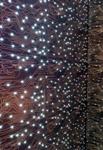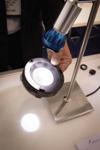Although the lighting market in Europe has been challenging of late, the industry continues with its headlong transformation towards greater adoption of LEDs, creating new business models and opportunities along the way, TIM WHITAKER reports.
Since its inception, Strategies in Light (SIL) Europe has focused on the issues affecting the region’s LED lighting industry, looking both at the transformation of the market and also the key technology issues. This year, SIL Europe took place in mid-September in Munich, Germany, and the conference was split into two parallel tracks on market transformation and technology. The opening day featured well-attended workshops on European standards for LED lighting, and the biological aspects of light.
Slow market growth
 Vrinda Bhandarkar, a research analyst with Strategies Unlimited, opened the Keynote session of the conference with an overview of the LED and lighting markets. The year-on-year growth in the global market for LED packages has fallen by an order of magnitude in each of the last two years: the market grew by 108% in 2010 and by 11.3% in 2011, and Bhandarkar predicted that 2012’s figure would be 1.5%. This would put the total LED revenue at $12.7 billion in 2012. Unit sales have of course grown far more rapidly in percentage terms, but this has been offset by a rapid decline in the price of both LED chips and packages. One factor has been the over-capacity of mid- and low-power LEDs, particularly among Korean and Taiwanese manufacturers. These devices were intended for use in the TV and display market, but are now increasingly being used for ambient lighting applications, said Bhandarkar. Prices for 4000K white LEDs are, on average, likely to drop below $4/kilolumen (equivalent to 250 lm/$) by the end of 2012, she said, with 2700K LEDs being about twice as expensive. Vrinda Bhandarkar, a research analyst with Strategies Unlimited, opened the Keynote session of the conference with an overview of the LED and lighting markets. The year-on-year growth in the global market for LED packages has fallen by an order of magnitude in each of the last two years: the market grew by 108% in 2010 and by 11.3% in 2011, and Bhandarkar predicted that 2012’s figure would be 1.5%. This would put the total LED revenue at $12.7 billion in 2012. Unit sales have of course grown far more rapidly in percentage terms, but this has been offset by a rapid decline in the price of both LED chips and packages. One factor has been the over-capacity of mid- and low-power LEDs, particularly among Korean and Taiwanese manufacturers. These devices were intended for use in the TV and display market, but are now increasingly being used for ambient lighting applications, said Bhandarkar. Prices for 4000K white LEDs are, on average, likely to drop below $4/kilolumen (equivalent to 250 lm/$) by the end of 2012, she said, with 2700K LEDs being about twice as expensive.
A number of speakers said that the lm/$ metric is rapidly becoming more important than lm/W, which has dominated technological progress in the last decade. Manuel Zarauza of LED supplier Seoul Semiconductor said that OEMs are already talking about figures as high as 2000 lm/$ (as well as 180 lm/W) by 2015.
Switching to the LED lighting products themselves, Bhandarkar said that the combined market for LED lamps and luminaires will grow at a CAGR of 17% from 2011 to 2016. Luminaires will grow at 19%, while the replacement-lamp market will grow at 11% and will saturate after 2014 at just over $4 billion per year.
Market transformation
Looking at the big picture, Bhandarkar said that commoditization is inevitable, partly as a result of government incentives and rebates. These encourage large-scale adoption, leading to commoditization and ultimately delivering the substantial energy savings that provide payback for those incentives. The industry is heading for a substantial shake-up, said Bhandarkar. “Consolidation to increase scale is inevitable,” she said. Also, the industry will take advantage of control systems to achieve greater energy-efficiency savings, although customized lighting design will also be required to make this happen.
Many speakers at SIL Europe focused on the transformation of the lighting industry. For example, Guido van Tartwijk of Philips talked about a three-phase transformation of the lamp market. Race 1 is to create “true replacements” for different lamp types that meet certain “good enough points” in terms of lumen output and efficacy (in lm/W). Race 2 is “aggressive cost down” to achieve “consumer-acceptable price points in a sustainable way.” This helps to build shipment volumes and reduce payback times. Race 3 is to add features, such as intelligence and networking, which lead to “new experiences” for the end user. Another speaker from Philips, Annetta Kelso, spoke about the market transformation of the European lighting industry, as described in detail on page 43.
 Jaap Schlejen of Samsung Electronics LED offered a different perspective, looking at three waves of development. The first wave was the introduction of high-power LEDs, which enabled architectural projects using colored LEDs, and various outdoor and indoor applications using white LEDs. The second wave was mid-power (MP) LEDs, which as discussed above became more prevalent when companies including Samsung installed excessive capacity for the TV backlighting market. Schlejen said that MP LEDs have enabled retrofit lamps to hit acceptable consumer price points, and that “MP developments make LED linear-fluorescent retrofits attractive.” Jaap Schlejen of Samsung Electronics LED offered a different perspective, looking at three waves of development. The first wave was the introduction of high-power LEDs, which enabled architectural projects using colored LEDs, and various outdoor and indoor applications using white LEDs. The second wave was mid-power (MP) LEDs, which as discussed above became more prevalent when companies including Samsung installed excessive capacity for the TV backlighting market. Schlejen said that MP LEDs have enabled retrofit lamps to hit acceptable consumer price points, and that “MP developments make LED linear-fluorescent retrofits attractive.”
The third wave is in “smart lighting”, using cost-effective integration of controls and intuitive user interfaces. “The third wave will be enabled by IC makers that can integrate complex functions,” said Schlejen. He added that many of today’s “stupid” professional lighting installations can be converted using “smart retrofits” that will enhance energy savings, safety and comfort. Schlejen concluded that the industry is buoyant, but some companies will need to be careful in their approach. Continuing with his wave theme, he advised: “Surf’s up. But don’t lose your pants.”
|

 English
English  Chinese
Chinese 





 English
English  Chinese
Chinese 



